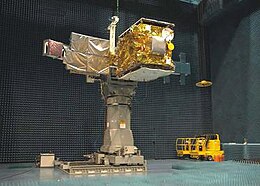GSAT-4

GSAT-4
|
|
| Mission type | Communication |
|---|---|
| Operator | ISRO |
| Mission duration | 7 years (planned) Failed to orbit |
| Spacecraft properties | |
| Bus | I-2K |
| Manufacturer |
ISRO Satellite Centre Space Applications Centre |
| Launch mass | 2,220 kilograms (4,890 lb) |
| Power | 2,760 watts |
| Start of mission | |
| Launch date | 15 April 2010, 10:57 UTC |
| Rocket | GSLV Mk.II D3 |
| Launch site | Satish Dhawan SLP |
| Orbital parameters | |
| Reference system | Geocentric |
| Regime | Geostationary |
| Longitude | 82° East |
| Epoch | Planned |
| Transponders | |
| Band | Ka-band |
GSAT-4, also known as HealthSat, was an experimental communication and navigation satellite launched in April 2010 by the Indian Space Research Organisation on the maiden flight of the Geosynchronous Satellite Launch Vehicle Mk.II rocket. It failed to reach orbit after the rocket's third stage malfunctioned. The third stage was the first Indian-built cryogenic-fuelled upper stage, and was making its first flight. The ISRO suspects that the failure was caused by the third stage not igniting.
Weighing around two tons, GSAT-4 carried a multi-channel, Ka-band, bent pipe and regenerative transponder, and a navigation payload in the C, L1, and L5 bands. Designed to guide civil and military aircraft, GSAT-4 was to have employed several new technologies such as a bus management unit, miniaturised dynamically tuned gyros, lithium-ion battery, 70 volt bus for Ka-band travelling-wave tube amplifiers, and electric propulsion. GSAT-4 also incorporated technological experiments like on-board structural dynamic experiment, thermal control coating experiment and vibration beam accelerometer. With a lift-off mass of about 2,180 kilograms (4,810 lb), the spacecraft was to have generated a maximum of 2,760 W of power.
GSAT-4 was also to have been the first Indian spacecraft to employ ion propulsion. Four Hall effect thrusters would have been used for north–south station keeping operations. Two types of Hall effect thrusters are developed by ISRO Satellite Centre (ISAC) and Liquid Propulsion Systems Centre (LPSC).
GSAT-4 carried the first GPS Aided Geo Augmented Navigation, or GAGAN, navigation payload. GSAT-4 was also intended to carry to the Israeli TAUVEX-2 space telescope array. Due to concerns that the new upper stage may have reduced the rocket's payload capacity, ISRO decided to remove TAUVEX in order to decrease the mass of the payload. GAGAN was still flown.
...
Wikipedia
